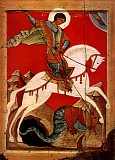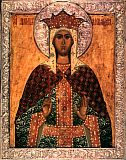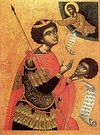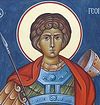

| Previous day | Next day |
| Old Style
April 23
|
Saturday |
New Style
May 6
|
| 3rd Week after Pascha. Tone 2. | No fast.
|
![]() Holy Glorious Great-martyr, Victory-bearer, and Wonderworker George (303).
Holy Glorious Great-martyr, Victory-bearer, and Wonderworker George (303).
Martyr Alexandra the Empress, wife of Diocletian (314). Martyrs Anatolius and Protoleon, soldiers converted by witnessing the martyrdom of St. George; and Martyrs Glycerius and Athanasius the Magician, at Nicomedia (303) Blessed George of Shenkursk, fool-for-Christ (1462).
Martyr Therinus of Bothrotus in Epirus (ca. 250). St. Adalbert (Voitech), bishop of Prague (997). New Martyr George of Cyprus, at Ptolomais (1752). New Martyr Lazarus of Bulgaria, at Pergamus (1802). King Solomon I of Imeretia (Georgia) (1784). New Hieromartyr Sergius Zacharczuk, priest, of Nabroz (Chelm and Podlasie, Poland) (1943). St. Sophia of the Panagia Kleisoura Monastery (1974).
Repose of Bishop Barnabas (Belyaev) of Nizhni-Novgorod (1963).
Thoughts for Each Day of the Year
According to the Daily Church Readings from the Word of God
By St. Theophan the Recluse

Saturday. [Acts 9:20–31; John 15:17–16:2]
When Saint Paul began to preach in Damascus, all were amazed, saying: Is not this he that destroyed them which called on this name? (Acts 9:21). Isn’t it always this way? Those close to someone who converts from unbelief to belief, or from sin to virtue, marvel over what happened has with this person. He did everything our way and now suddenly everything has changed: his words and his gaze, his step and his thoughts are not the same, and his undertakings are different, and the places where he goes are different. It is as if one were walking toward the west, and then suddenly turned around to the east. These two lives are contradictory and mutually exclude one another. He who wants to combine them, or to make a whole life with part from the one, and part from the other, will waste both time and effort with no success. What can these lives have in common?! Only those who do not understand things can say, “Why does it have to be so drastic!”
Articles
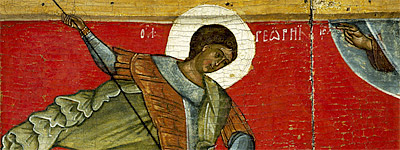 Great Martyr George |
